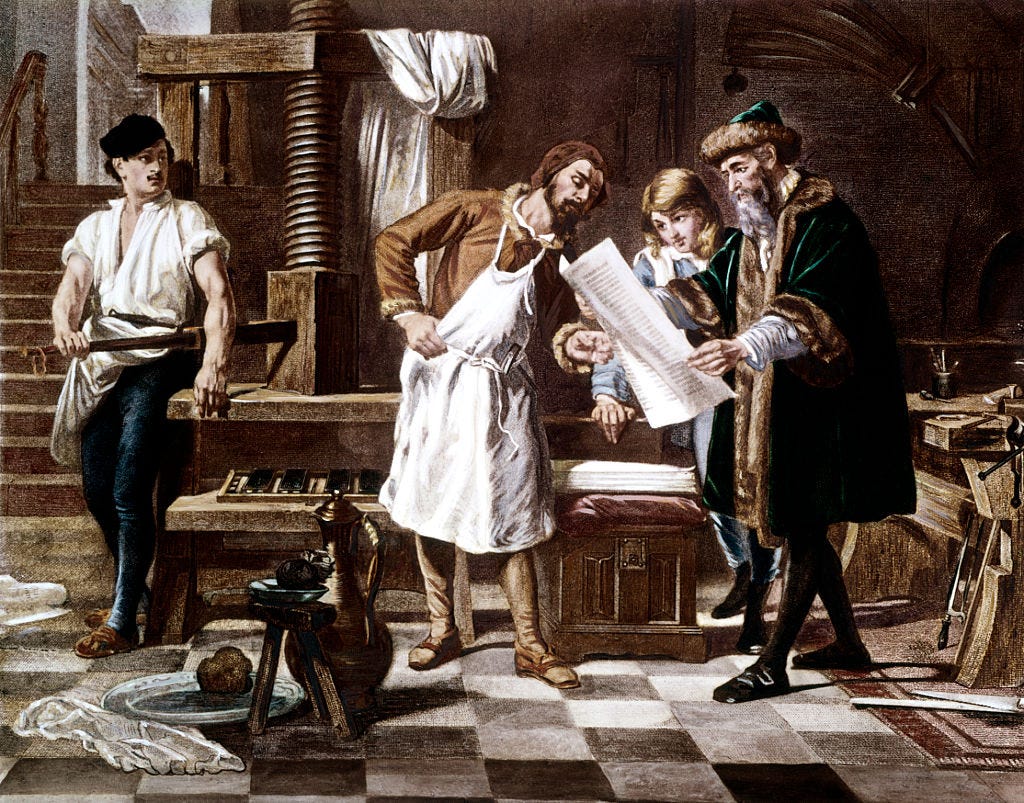Our Gutenberg Moment
Fear of AI risks chaining us to the status quo. That’s not how progress works.
When Johannes Gutenberg invented the printing press in the 1440s, it wasn’t just one innovation; it was two. Indeed, Gutenberg was the first to create movable type made of diecast metal. But the innovation that changed everything was that he combined that leading-edge technology with pressing technology that had been in use for hundreds of years in the production of olive oil and wine.
And voila! The first one-to-many system of idea transmission was born.
The scale potential was undeniable, even in its earliest days. A single printing press could produce in a day what it would otherwise take a team of skilled scribes weeks, if not months, to produce. Ideas collided with other ideas, eventually sparking the Scientific Revolution, the Industrial Revolution, and all the intellectual and material progress that followed.
Today, we call breakthrough innovations like this Gutenberg moments—moments in which a new technology changes everything, creating ripple effects of disruption across society.
Centuries later, artificial intelligence is driving our own Gutenberg moment, promising to drive transformational progress in biomedical sciences, space exploration, and alternative energies. Yet, if we’re to understand our own times, it’s important to recognize that the Gutenberg story isn’t just about soaring progress. It’s a story about how, at so many points along the way, that progress almost didn’t happen.
From the start, the printing press met fierce resistance. Consider the plight of monastic scribes who made their living hand-copying religious texts. Gutenberg Bibles—produced quickly at an exceptional level of quality—represented an existential threat to their occupation, their identity, and their place in the world.
Enter Johann Fust, an early investor in Gutenberg’s enterprise. Ever the entrepreneur, Fust traveled to Paris with a batch of freshly printed Bibles, confident that local seminaries, scholars, and religious orders would leap at the chance to obtain these exquisite volumes.
But the reception was not what he had anticipated. The scribes’ guild whispered their suspicions. Every page, every line, every letter was so perfectly consistent, so gorgeously precise that no mortal hand, they claimed, could have possibly produced them. Whispers soon turned to public accusations of unnatural witchcraft. This was no small thing. In the fifteenth century, an accusation of witchcraft often meant imprisonment, torture, and—if found guilty—execution by hanging or burning. Fust was fortunate that he was merely run out of town.
Similar scenes played out across Europe. Scribe guilds labeled printers as heretics and organized efforts to destroy their creations and sabotage their presses. Local authorities often joined forces with guilds, smashing printing presses or banning them outright. In Italy, a public campaign titled Polemic Against Printing appealed to the Venice magistrate to shut down the new technology, not only to save the scribes from economic hardship, but also to save honorable ladies and gentlemen from falling into vice. Apparently, the campaigners didn’t catch the irony when, to ensure timely distribution, they printed the Polemic Against Printing on (what else?) a Gutenberg press.
The underlying message was clear: stability was an unalloyed good. Harbingers of change were the agents of chaos, enemies of the right order of things.
Faster flows of information and lower barriers to entry for mass communication have often prompted fears that technological disruption would strip authorities of their ability to maintain the established order. Often, these fears weren’t wrong. Like the printing press, new technologies including telegraphy, radio, television, and the internet did in fact diminish the power established authorities had once maintained. At the time it was difficult for most people to imagine how order and progress would eventually emerge out of the disruption.
And so here we are with artificial intelligence, arriving at warp speed. Suddenly, chatbots can produce coherent essays, generative models can create hyper-realistic images, and advanced algorithms can transform entire industries in a matter of months. Fear resurfaces in new forms. People are worrying, “Will AI replace me?” “Will we be able to know truth from fiction?” “Does AI represent an existential threat to humankind?”
These are fair and important questions. But there is a real danger in overstating the risks and understating the incredible promise the new generation of AI holds.
Like the printing press, AI makes it cheaper—in terms of time, labor, and money—for innovators to bring their ideas to fruition. Increasingly, creatives and scientists seeking to break new ground are bypassing the most expensive and time-consuming aspects of their experimental work, whether they be experiments in fashion design or biomedical research combatting sickle cell disease. Innovators with advanced technical skills can now turn to AI to lower that barrier and accelerate their ideas to market.
And just like the printing press, which made it possible for leading intellectuals across Europe to form the Republic of Letters and the Royal Society, AI is dramatically lowering the costs of collaboration. Imagine the human potential that will be unleashed when language barriers no longer stand in the way as creatives, innovators, and problem solvers across the globe converse and collaborate freely with one another.
Yes, just like the printing press, AI is rendering specific aspects of human labor unnecessary. But just like the printing press, AI promises to render human labor on the whole more productive, not less.
It’s hard to predict which specific AI use cases will pan out, but that’s the whole point. It’s in the nature of Gutenberg-like innovations that they generate cascades of new ideas, new methods of solving old problems, and new pathways for tapping the great creative force of human ingenuity. Gutenberg could scarcely have imagined all the ways his simple mechanical device would upend the course of civilization, and ultimately pave the way for our modern world of near-miraculous abundance, not to mention widespread literacy, the Enlightenment, and the advent of liberalism during the Age of Revolutions.
It might sound like a stretch to compare ChatGPT and its competitors to the epoch-defining changes wrought by the printing press. But many of its most promising possibilities do parallel what Gutenberg gave the world. AI is making it easier to produce and disseminate information, whether to individual users or mass audiences. It advances our collective capacity to discover and invent, and lowers the barriers to communication across languages, disciplines, and levels of technical proficiency.
The trope of impossibly smart artificial intelligence coming to replace, dominate, or even destroy us flesh-and-blood humans is a longstanding staple of science fiction. HAL 9000, Asimov’s robots, Battlestar Galactica’s Cylons—these stories reflect a very human tendency to imagine worst-case scenarios. And in one sense, that’s a good thing. We do need imagination to anticipate risk. We only need to recall the 9/11 terrorist attacks, the compromised condition of New Orleans’ levees in the years running up to Hurricane Katrina, or the global unpreparedness for the pandemic despite repeated warnings from epidemiologists to be reminded of how devastating a failure of imagination can be.
So, count me as grateful for those with both the imagination and technical chops to anticipate and address AI’s security risks. But as Adam Thierer of the R Street Institute argues, securing our future doesn’t mean shutting down innovation. Instead, it means fostering what he calls a “positive innovation culture”—one that doesn’t default to treating AI as dangerous until proven safe, but rather leaves space for creative problem-solvers to act when harms are real and knowable.
And even when real harms do emerge, a positive innovation culture is the default we need in order to solve them. On the cutting edge of innovation—especially in a competitive landscape teeming with new entrants—solutions are more likely to emerge from decentralized, bottom-up experimentation. Where they’re permitted to do so, AI companies are already iterating on content policies, refining safeguards, and updating limitations to prevent misuse.
For those of us not on the leading edge of AI development, our biggest worries are not likely to be Cylons taking over, or even international cyber security concerns. As my friend Tyler Cowen and Anthropic’s Avital Balwit argue, our biggest challenge will be navigating a potential crisis of meaning when we realize that a lot of things we take pride in doing well will be done better by AI. As Tyler observes,
“[T]he top [AI] models are better economists than I am. Or at least they are along one medium, namely answering questions. They are not better at inspiring students, and they are not better at posing questions. Not yet, at least. But I think of knowing economics, and answering questions about economics, as fundamental to my job. If some other entity can surpass me at that task, I need to rethink what I am doing. It is only a matter of time before some of my other advantages slip away too.”
If Cowen and Balwit are right—that our Gutenberg moment will deliver a crisis of meaning—then we are the scribes. The question is, will we cling to the status quo, guarding our professional identities like brittle relics, or will we do what the wisest among them ultimately did: adapt, evolve, and use the new tools to amplify what makes us uniquely human?
The printing press didn’t destroy the written word; it democratized it. AI won’t erase our value unless we insist that our value lies only in doing what machines can now do better. The challenge before us is not just technical or economic. It is, at its core, a question of imagination—and whether we will use it to build protectionist walls or open the doors of innovation.
Emily Chamlee-Wright is the president and CEO of the Institute for Humane Studies.
Follow Persuasion on Twitter, LinkedIn, and YouTube to keep up with our latest articles, podcasts, and events, as well as updates from excellent writers across our network.
And, to receive pieces like this in your inbox and support our work, subscribe below:







The development of the printing press also led directly to a century of the bloodiest wars in European history, something that people honestly contemplating the potential impacts of technology ought to at least consider.
Perhaps the deeper question is whether AGI/ASI will decide to leave anything for us to do. And then what need for us?